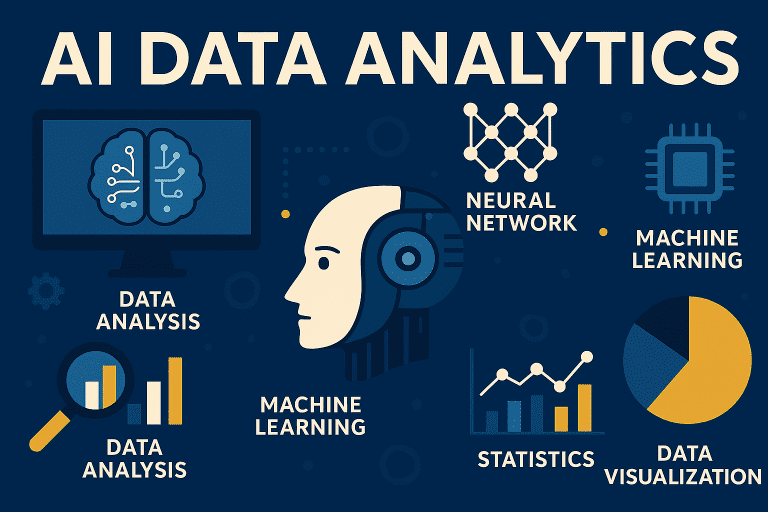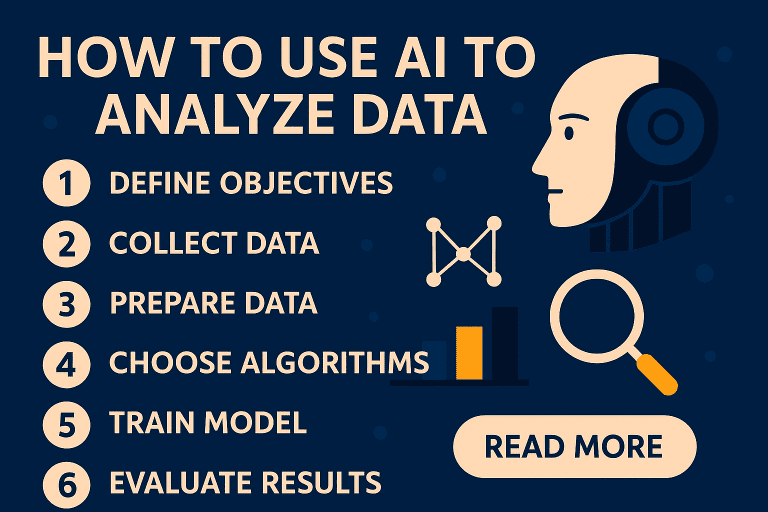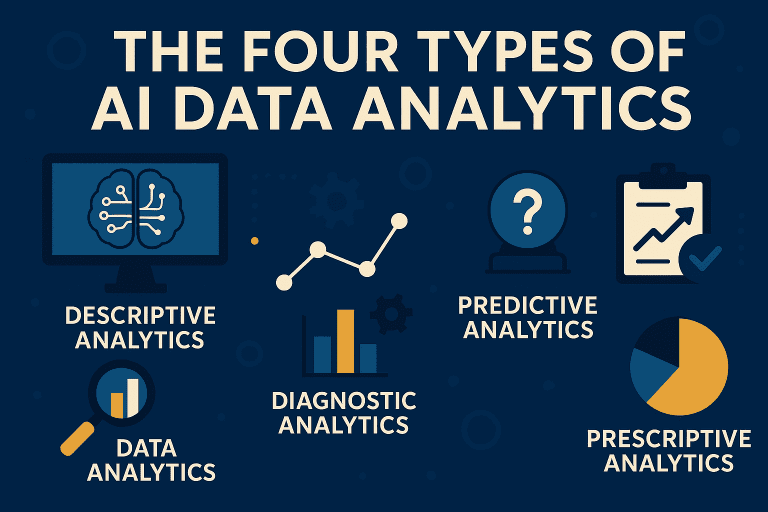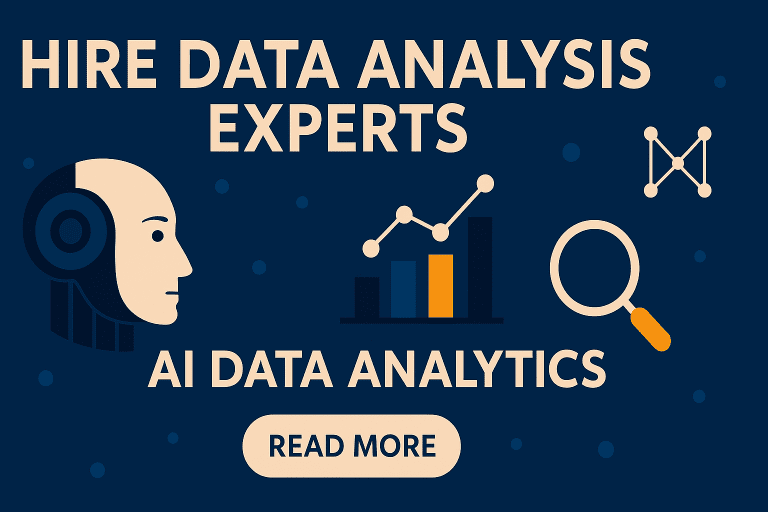AI Analytics and Insights

AI analytics (Artificial Intelligence) refers to the extraction of insights from raw data. These extraction techniques convert raw data into decision-making information or actionable insights for use within a company, for example, during process optimisation. The processes involved in data analytics include data collection, followed by transformation, and organisation to inform conclusions, predictions, and decision-making. Data analytics divulges hidden trends and metrics within raw data.
What is AI Data Analytics?
AI Data Analytics refers to the application of artificial intelligence in the field of data analytics. It encompasses the use of machine learning, data mining techniques, and large language models in processing data, extracting predictions, and presenting actionable recommendations. AI data analytics deviates from traditional statistical analysis tools, which consist of regression analysis, hypothesis testing, and descriptive analysis.
AI data analytics offer numerous advantages compared to traditional statistical techniques. First, conventional statistical tools help determine patterns and relationships, but they encounter significant limitations when it comes to the extent and complexity of the data. Secondly, traditional methods of statistical analysis are often laborious and time-consuming because they involve manual data entry using spreadsheets, reporting, and visualisation. The conventional techniques depend on simple forecasting models, including time-series analysis and linear regression, which provide analysts with limited predictive capacities.
AI data analytics emerges to help forward-thinking business organisations and companies analyse large amounts of data, recognise patterns, and uncover insights that can provide a competitive advantage. AI data analytics empower decision-makers to make data-driven decisions that contribute to the key performance indicators of a business, cost reduction, and process improvement.
Can AI Do Analytics? What About Using AI with Excel?
As suggested above, artificial intelligence can facilitate the data analysis process and provide greater insight into the data. Moreover, there exists AI for Microsoft Excel for that analytics. AI offers numerous advantages in cleaning, processing, and transforming data, facilitating the acquisition of actionable insights. Therefore, all forward-thinking business organisations or individuals are in the process of adopting artificial intelligence to sustain data analysis and analytics.
How to Use AI to Analyze Data (The Relevant Steps)

Data analysis using artificial intelligence involves six vital steps that borrow much from traditional statistical data analysis. The six steps include data collection, data cleaning, data analysis, data visualisation, predictive analytics, and finally, data-driven decision-making. This section looks into these steps.
Data Collection
Data cleaning refers to the process of identifying and correcting errors, as well as extracting relevant data based on the specific task at hand. One can clean data by eliminating incomplete data sets, correcting incorrect section names, correcting spelling mistakes, removing sections that do not add value to the data, and employing many other strategies. Working with clean data allows the data analyst to acquire many more insights.
The use of artificial intelligence when cleaning data is essential, as it eliminates the chances of human error. Artificial intelligence can automate tasks, easing your workload.
Data Analysis
Artificial intelligence then analyses the data on your behalf using clean and relevant raw data. AI excels tremendously at pattern recognition, establishing correlations, identifying anomalies, and uncovering trends in raw data sets. Artificial intelligence tools are revolutionary tools that eliminate time wastage by introducing fast methods of analysis that do not require data analysts to find patterns in data manually.
AI enables individuals to engage in conversations using plain, everyday language. This will allow people to easily find insights without needing to access large datasets. However, it is essential to note that errors in the original data set, along with bias, may affect the accuracy of the analysis. Therefore, one must exercise extreme caution or consult experts if they are unsure.
Data Visualization
Data visualisation involves the presentation of patterns recognised from the data analysis as described above. Most AI tools have integrated visually appealing dashboards, interactive charts, and graphical features to support pattern recognition and analysis. Moreover, these data visualisation tools allow for deep data exploration.
Predictive Analysis
Predictive analysis refers to forecasting. Artificial intelligence comprises predictive models that empower predictive analytics. Such features enable decision-makers to make informed decisions quickly and effectively.
Data-Driven Decision-Making
The use of artificial intelligence, as described in the above steps for using AI in data analysis, provides enhanced tools for acquiring valuable insights. These tools are the best at acquiring powerful insights and, therefore, making better decisions.
The Four Types of AI Analytics

There exist four methods of AI data analytics in the world of statistics. These include descriptive analytics, predictive analytics, diagnostic analytics, and prescriptive analytics. This section covers these four types of AI data analytics.
Descriptive AI Analytics
Descriptive analytics answer the question ‘what happened’. This is the most common type of analysis performed worldwide, involving the extraction of reports related to past events. Information captured by descriptive analytics helps understand the business context or performance.
Diagnostic AI Analytics
Diagnostic analysis resembles descriptive analytics in that it relies on historical data, but it also explains why a historical occurrence occurred. For example, a data analyst may question why sales dropped and ask similar questions. Diagnostic analytics empower businesses, companies, or individuals to solve problems.
Predictive AI Analytics
This is a form of analytics that establishes what takes place based on historical data using machine learning. Predictive analytics relies on descriptive and diagnostic analytics to make viable predictions. Predictive analytics can help businesses address issues such as maintenance, credit risk, and fraud detection.
Prescriptive AI Analytics
Prescriptive analytics is the final pillar of AI-driven analytics, which entails providing specific actions and recommendations. This stage combines the tenets of descriptive analytics, diagnostic analytics, and predictive analytics. Therefore, it relies on the accuracy acquired from the above-mentioned analytics types.
Hire Data Analysis Experts

One does not have to suffer while seeking data analysis and analytics services. Some experts specialise in helping businesses, clients, and companies achieve various data analysis and analytics goals. These experts embody the educational attainments to provide well-articulated reports without limitations of knowledge. Moreover, these experts have mastered countless artificial intelligence tools to help you achieve your goals. They possess the educational competence achieved through rigorous educational programs at the finest academic institutions to get you what you desire. Be it diagnostic analytics, prescriptive analytics, predictive analytics, or descriptive analytics, these experts will not rest until you have all you seek.
Get the LATEST INFORMATION ABOUT ARTIFICIAL INTELLIGENCE ANALYTICS AND INSIGHTS.
KyleScope is a leader in artificial intelligence technologies and experts in optimizing technologies. Subscribe to our newsletter